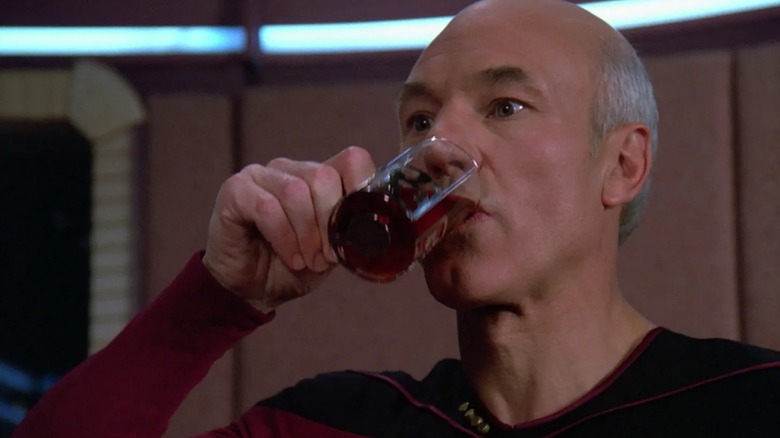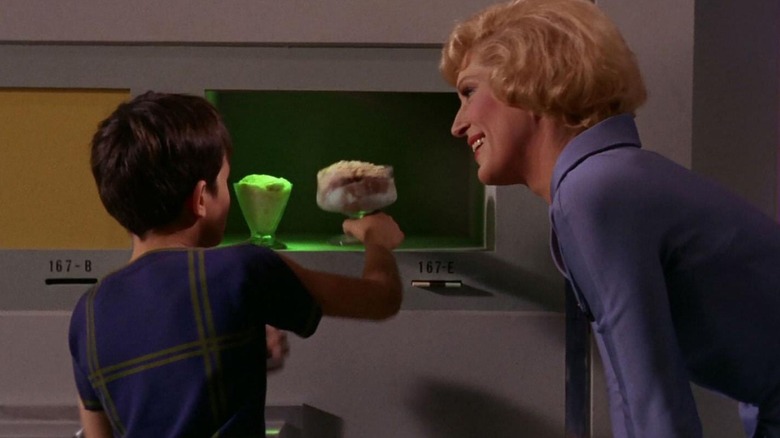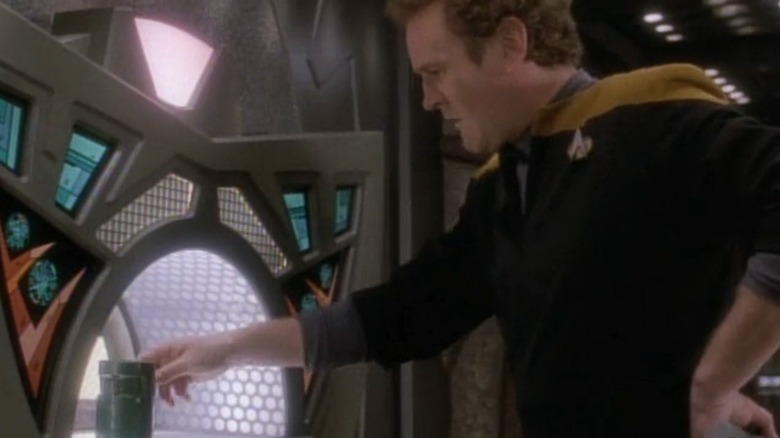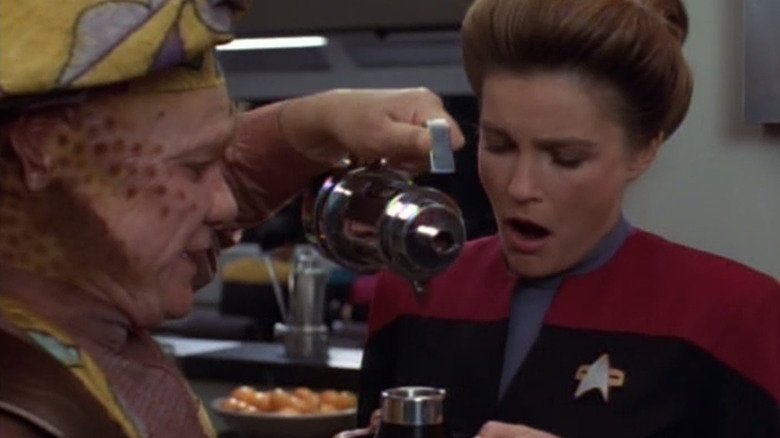In Star Trek, You Eat Your Own Poop: Or, Replicators Explained
It took a long time for the writers of "Star Trek" to codify the technology on screen, so food replicators have been known by many names over the years. Sometimes it was called a molecular synthesizer, or a food synthesizer. Sometimes it would merely be referred to as a "food slot," which sounds less like a marvel of technology and more like an old-timey coin-operated automat. By the days of "Star Trek: The Next Generation," however, the name "replicator" finally stuck, and viewers could rest assured that a starship populated by over a thousand people has efficient means of feeding its denizens.
On-screen, replicators are perhaps one of the more magical technologies in "Star Trek." Replicators are small alcoves on the wall, equipped with a giant computer, usually located inside crew quarters. A crew member can walk up to the alcove, speak the name of a food or a beverage, and said object will instantaneously materialize. Provided the food or drink in question is programmed into the ship's database, anyone can have whatever meal they want at any time. Hunger is a thing of the past. All the replicator needs is information about cells and proteins, and the raw energy to make something. Captain Picard (Patrick Stewart) regularly ordered cups of Earl Grey tea during his shifts.
It turns out, though, that Picard might technically be drinking his own bodily waste. The dark secret of replicators is that they convert energy into matter, very much the same way the Enterprise's transporters do. That means, of course, that spare matter needs to be transformed into energy first. And where do you think that matter comes from? Longtime "Star Trek" technical advisor Michael Okuda confirmed that at least some of the replicators' energy store comes from matter salvaged from the ship's toilets.
The ship's galley
Of course, replicators weren't standard equipment on "Star Trek" until the days of "Next Generation." Prior to that, Federation starships seemed to have a few replicators that provided a few meals here and there, but most foods were still prepared in a galley, largely kept off-screen until "Star Trek VI: The Undiscovered Country." In that film, several senior officers had a conversation in the Enterprise's galley, and one of them even vaporized a steel cooking pot with a phaser. Comedically, the gluey porridge-like substance inside the pot was not vaporized and even kept its shape.
In the original series, however, it was always a little canonically hazy as to how widespread the replicator technology was. Generally accepted among Trekkies — but not necessarily canonical — is that chefs on the Enterprise could replicate small dishes or specific ingredients, but tended to use ingredients stored in an outsize pantry. If the Enterprise seems large, consider how much of its volume may be stocked with provisions. Doubtless, every space-saving measure is in play, but still, that's a lot of food. The original Enterprise's complement was over 400.
Replicators weren't yet invented in the days of "Star Trek: Enterprise," as that show saw humans encountering the technology for the first time. There was also a lot of talk on "Enterprise" about a character called Cookie, the show's unseen galley chef. Cookie would eventually be play-acted by Commander Riker (Jonathan Frakes) on the holodeck, and the character became strangely important in the show's final episode. Given the limitations of technology, one can imagine that the food on "Enterprise" wasn't very good. Luckily, Cookie only had to cook for 83 people.
But, yeah, you eat your poop
In the pages of the invaluable "Star Trek: The Next Generation Technical Manual," co-author Okuda noted how the Enterprise's replicators are tied directly into the ship's sewage system. Toilets aren't really seen much on "Star Trek," but Trekkies who have ogled blueprints all know where they are located. Okuda wrote that the crew's organic waste is "pumped to treatment and recycling units located in the environmental support complexes on Decks 6, 13, and 24." Via the ship's filtration process, "resulting water is superheated to 150°C for biological sterilization." Once sterilized, the urine is "returned to one of several freshwater storage tanks for reuse." Yes, there is a store of fresh water on the Enterprise-D. Yes, it's made from pee.
As for the solid waste — or, in Okuda's words, "various waste sludges" — it is "electrolytically reprocessed into an organic particulate suspension that serves as the raw material for the food synthesizer systems." Then all of the "remaining byproducts are conveyed to the solid waste processing system for matter replication recycling." Matter replication recycling. They recycle poop into food.
Yes, it's mere energy by the time it makes its way to the replicator's energy systems, and naturally, the bacteria have all been removed, but the people on "Star Trek" are such efficient recyclers that they do indeed eat their own poop. Also, all their other trash. All waste matter — old clothes, dated tech, or mere trinkets you don't want anymore — can be placed on a replicator and de-materialized back into energy at a moment's notice. It's then reused to make new foods and objects. However, the dematerialization process wouldn't be demonstrated on-screen until an episode of "Star Trek: Voyager."
The limits of replicators
Of course, "Star Trek" technology requires limitations, otherwise a lot of dramatic tension would be broken. It's been implied many times over various Trek series that replicators require a lot of energy to operate. Hence, a prankster can't program a replicator to keep making food until the ship's hallways fill with SpaghettiOs and the hull begins to buckle. This notion was reinforced by the events of "Star Trek: Voyager," which saw its title ship stranded 70 years from home. To save energy, replicator access was rationed, a hydroponics bay was erected, and a galley was built. The ship needed a sustainable food source, and replicators weren't it. This became an issue when Captain Janeway's beloved coffee beans were nowhere to be found.
It's also repeated throughout Trek that replicated food ... isn't that good. Several characters note that they can taste when food is synthesized, leading to many amateur chefs trying their hand at cooking in their quarters. It seems some galley equipment is always on hand, just in case. Replicators, though, seem to leave little room for culinary alteration of its programs.
As previously noted in the pages of /Film, alcohol cannot be produced by a replicator. Ancillary technical manuals also explain that poisons can't be replicated. Although whether or not benign ingredients for one species may be poisonous to another hasn't yet been addressed in canon. Perhaps the replicators make foods that are acceptable to every digestive system on the ship.
Replicators are also only capable of replicating smaller objects. No one on "Star Trek" has ever been seen replicating anything larger than a coffee table book. One cannot replicate, for instance, an entire starship.
Of course, if you can replicate a starship, you'd likely be so powerful that you wouldn't need to.



